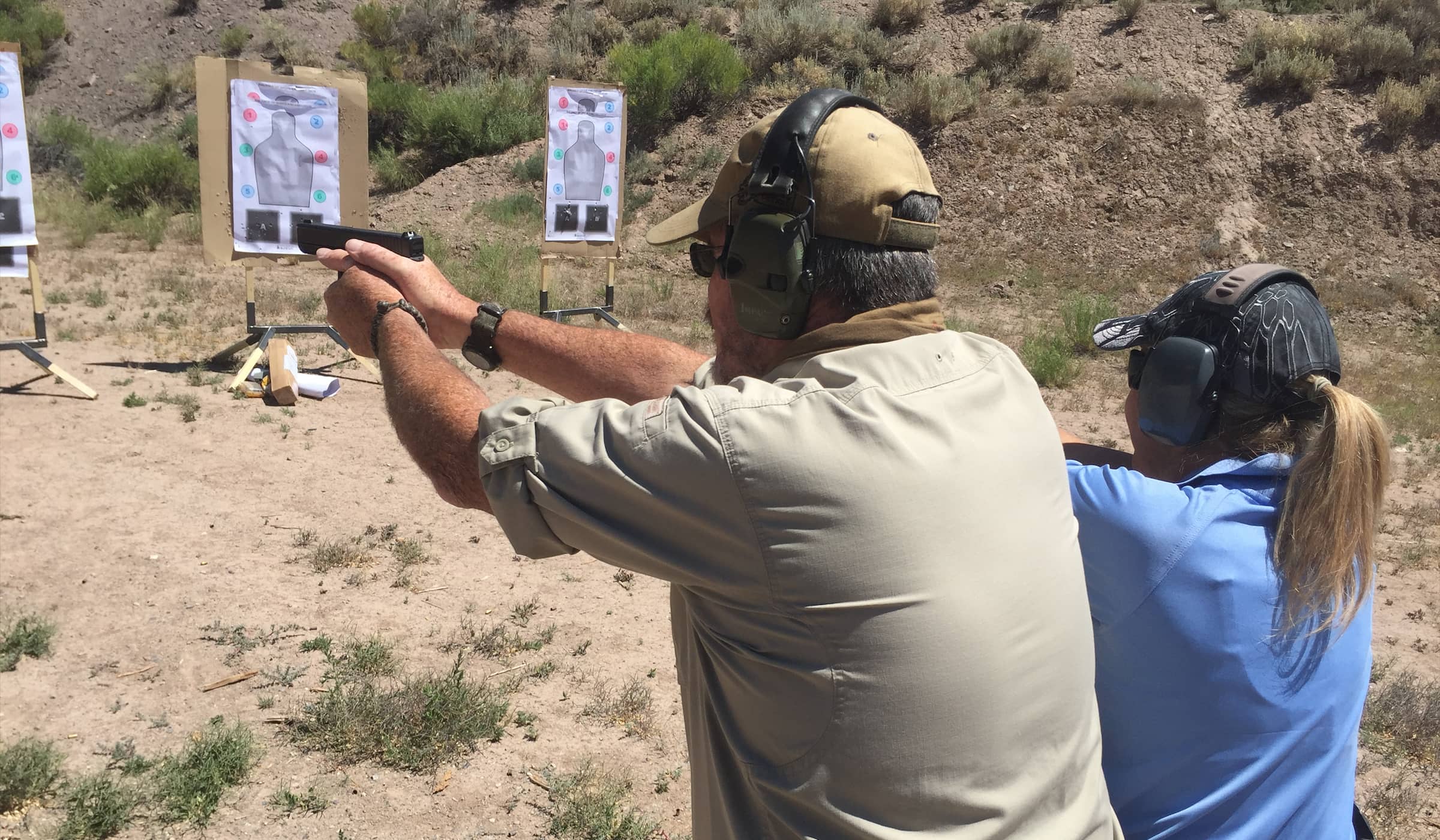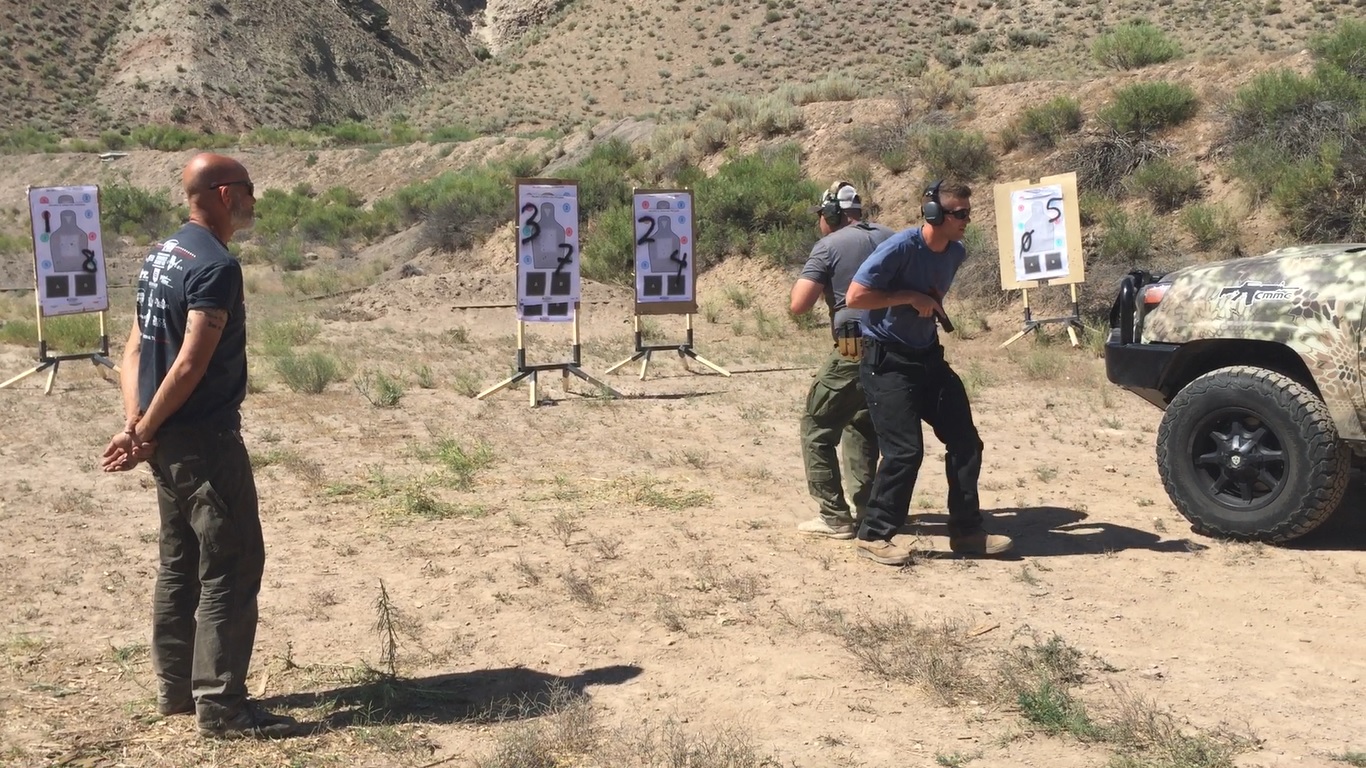Training as a team; Two Person Armed Defense
Terry Nelson 11.16.18

Have you ever considered combining your live fire training with another person that you may spend a great deal of time with in your daily life, perhaps a good friend, a coworker or your spouse? With today’s continued threat by an active shooter, training as a team is certainly a valid approach. Are you and your close friends or family armed on a daily basis? I certainly hope so. If so, the advantages of training as a team in the event of an active shooter event or armed attack should be obvious. As hard as police try, the reality is they will most likely not get to you in time. Bottom line, you and the person with you may be the only hope in the case of an immediate threat.
Just over a year ago I attended a course that focused on an armed situation where you and another may be forced to work as a cohesive unit. The course entitled “2 Person Armed Defense” (2PAD) provided some excellent insight into working with another armed person in a self-defense situation. This course along with many others is firearms training offered by Personal Defense Network (PDN) and its Executive Director, Rob Pincus.
Pincus was the on-site instructor for this particular 2PAD course held at the Gypsum, Colorado Gun Club Range in June 2017. An overview of critical firearms safety rules started off the day as it always should. Pincus then discussed what he calls the “3 C’s Foundation” of communication, coordination and cooperation when it comes to teamwork. These concepts were reinforced throughout the day.
An additional key point made early on in the day is that an “individual response” is usually the first and a normal reaction in any high-stress event. Keeping this concept in mind, the day’s training focused on moving to or with your partner after your own immediate response as an individual. Once these basics were well ingrained, we moved on to a series of live fire drills, based on two people having to work together.
The following are key drills utilized during 2PAD training:
Extend your handgun/Touch and Press Trigger
This was one of the few individual drills and started out at the five-yard line. This distance is common to defensive actions in the average armed confrontation. Maintaining a good stance, (squarely facing the target with feet placed shoulder width apart) and a firing grip on your handgun (Sul position most often), the student would extend or the pistol straight forward while beginning trigger touch, and immediately press the trigger as the muzzle was on the threat/target. All the while the focus is on high center mass of the target, looking into the desired strike zone (not the normal sighted shooting).
This technique provides good defensive accuracy and is fast at the five- to ten-yard line. The drill was repeated several times all while increasing rounds fired from two and up to six. This combat focus drill is a trademark drill of PDN and Pincus and is worth adding to your training regime.
If you have not used the Sul or indoor ready position as it is sometimes called, take a look at the following link: https://www.personaldefensenetwork.com/article/firearm-ready-positions/
Move with your team mate and shoot
This segment began to ingrain the skill of movement into defensive shooting. Each two person team would move laterally a few steps when the shoot command was given. The movement was not necessarily side by side but could be towards each other. The intent was to get a degree of comfort in working with another armed person with the added stress of movement and combat-accurate fire on the threat. Movement was also encouraged after firing, which began the lead up to the next training drill: moving to your partner and then firing.
Move to team mate and engage threat
In a situation of you and another armed citizen not knowing where the attacker is, then moving towards each other could very well provide an advantage. The argument exists that it would become somewhat easier for the attacker to take both of you out. This drill has valid training points but ideally should be practiced often with your armed partner. This drill begins as one of the pair observes a threat, moves and begins firing. The second of the team would then draw their handgun and move to assist their partner (utilizing the SUL position). The goal for the second partner would be to cover 360 for additional threats and look for an escape route. Ideally you and your teammate would literally be pressed up against each other, back to back, with the “rear guard” so to speak, grabbing onto the belt of their partner to help lead them to a more secure zone at the first opportunity. In the event the partner shooting ran dry on ammo or had a malfunction, they would call for the “rear guard” to cover and rotate towards the threat to engage.
This drill may sound a bit nerve wracking (any real shooting would be) but I found it to have real-world application and a way to shape thinking of an effective response should the need ever arise.
The Figure 8
Over the day, all drills were continued so as to reinforce the keys concepts. In addition, working through doorways and around vehicles was added in and always with a partner. Pincus likes to key in on the immediate and individual startled response, which is very probable in the real world. A good drill that the teams performed, helping to instill this surprised response, was the figure 8 drill.
A pair of students would walk in a figure 8 (crossing each other paths) parallel to the targets. Pincus would then call out numbers (numbers were drawn on targets with a marker) the student pair would turn towards threats (targets), which were scattered at varying distances, and engage the appropriate numeral(s) with multiple shots. Each student would fire only at the threats on their appropriate side. This is a dynamic drill and as close to realism when having to find and identify the threat while engaging as any I’ve done, and all the while working with another armed citizen.
During the entire course and for all drills, Pincus reinforced the importance of a valid 360-degree scan. What are you scanning for? In order of priority: additional threats, other armed citizens or law enforcement that you don’t want to get shot by, other folks that may be willing to help you or others in some way, and then a position of advantage, such as cover, a clearer shooting position, or other position of tactical advantage.

Ammunition requirements for 2PAD are 400 to 500 rounds range over a full day of training. This training course was a different approach than many others I have attended, especially from a civilian perspective. It provides insight into the reality of working with another armed person and I would not hesitate to attend again.
For many long years I have trained in law enforcement, both as a student and as an instructor, and now in the civilian world. If there is one good piece of advice I could give to any student of defensive living and mindset, it would be to keep pushing yourself with valid training and a proper attitude. Rob Pincus and Personal Defense Network provide just such training.

